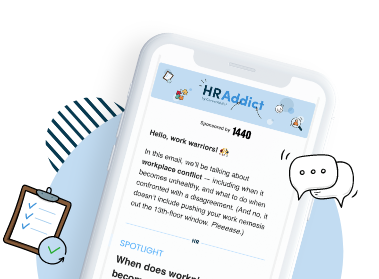This guest post is written by Ksenia Melnychenko from Headway.
Microlearning methods are very different from the usual long training courses. Think of it this way: employees in a meeting room attend a 15-minute workshop that encourages them to learn in short, focused sprints. This gives them something they can actually use right away.
With tidbits of learning using just a few minutes a day, you can retain lessons better than a three-hour training session. You get the same knowledge, but in pieces that your brain can process more easily.
More companies now use microlearning to keep staff learning without pulling them away from daily work. But let’s look at this year’s microlearning trends that will further shape L&D.
TABLE OF CONTENTS
What is microlearning?
Industry research shows the mobile learning market is heading toward $110.42 billion in 2025, up from about $86 billion the year before. Such growth doesn’t come from hype. It comes from people like you squeezing small learning moments into already packed days.
Microlearning means learning in short bursts, like two to five minutes, each built around one skill. For example, a three-minute module on resetting CRM will stick far better than a long webinar covering multiple tools.
How does it work?
You open the app or platform, and it asks what you’re working on (maybe acquiring new skills, maybe developing leadership). You pick the topics, and the system gives you a summary or lessons you can read or listen to. For example, let’s take the book summary app that’s focused on microlearning. It usually cuts a 200-page book into sections with the main takeaways of each chapter. You also get highlights, quotes, and further practical features.
It may push you a little with daily reminders and small challenges. Not aggressive, but enough to remind you that you wanted to finish that book. That factor matters because reading is easy to skip.
With microlearning apps designed for the workplace, employees can continually acquire new skills without waiting for the next annual training event. They can also use quiz or flashcard apps, or apps that deliver the main ideas of a book in under ten minutes, which are proving to be especially effective. The same model is now being used inside corporate training, breaking away from lengthy sessions and rethinking how skill development fits into daily routines.
Headway’s 2025 study of US remote workers found that most manage six hours or less of focused work a day, and 26% admitted to skipping entire workdays unnoticed. The results show why short formats are becoming more in demand: people want to be more productive, but their energy is limited. Microlearning modules are known to have a higher completion rate than long-form courses. Why?
- Time fit: you can finish one on your commute or coffee break
- Retention: shorter bursts mean you actually remember and apply the lessons
- Cost: companies spend less on producing micro modules than on full courses
6 key trends and use cases: Where microlearning shines
With microlearning, you also don’t have to worry about learners with short attention spans. There are three ways it can make content stand out:
- Mobile-first delivery: To help learning schedules fit into breaks or downtime.
- AI-powered personalization: Platforms now adapt content based on performance and skill gaps.
- Gamification and social features: Challenges and interactions keep employees engaged longer than slides ever could.
1. Rapid AI-built content and short-form videos
You’re seeing tools like ChatGPT, Claude, and similar platforms generate modules fast. A recent academic preprint, ‘The Reel Deal: Designing and Evaluating LLM-Generated Short-Form Educational Videos,’ shows that LLM-generated short videos beat long lectures in engagement and quiz performance (in a test with 62 students) without overloading them. This means you can convert longer content into reels that still deliver results.
Onboarding and orientation use case
You can use such a method if new hires don’t need a firehose of policies on day one. With microlearning, you can deliver the essential parts in small chunks. A quick welcome video, a micro-quiz on company values, and a simulation of logging into core tools can get them up to speed without being overwhelmed:
- Short digital ‘day-one’ walkthroughs
- Role-play simulations for customer service roles
- Gamified onboarding checklists that track progress
2. Gamification and real-world scenarios
Do you like games? Because microlearning gamification is not just about badges, you get complex scenarios and decision-making points tied to real work. For example, a service rep will pick responses in a simulated, tough client call and see the potential results based on real cases. Some companies include this in their microlearning modules during training.
Compliance training case
Regulatory updates usually bore and overwhelm employees, but microlearning makes training digestible. Instead of a 90-minute lecture on GDPR, you push three modules: data privacy basics, real case scenarios, and a short quiz with instant feedback.
3. Interactive videos
This entails watching more short video modules. More organizations now include videos in microlearning lessons. What’s changing: the videos often include clickable prompts, so it’s not the usual passive learning method. This is useful in product knowledge learning sessions.
Product knowledge use case
Sales and support teams need fast refreshers. You can give them mobile-ready solutions, like short demo videos with interactive features. Examples are flashcards and scenario-based simulations:
- ‘What’s new’ two-minute product videos
- Micro-quizzes after feature launches
- AI simulations of customer objections and responses
4. Just-in-time performance support and adaptive paths
You get help when you need it. Whether you’re about to speak publicly or handle a meeting, some AI tools within micro-apps offer real-time tips or micro-modules you can pull up anytime.
Adaptive paths adjust lessons based on needs: if you struggle with empathy, you see more modules on that; if you’re making good progress, it speeds you up to more advanced topics. You’ll probably see “rapid AI design” and “adaptive learning paths” as one of the top trends in microlearning.
Leadership development use case
Simply put, managers rarely have time for half-day workshops. Adaptive microlearning could be used to support leadership growth through short lessons on emotional intelligence, conflict resolution, or, let’s say, when you need to improve your leader’s decision-making skills. You can use:
- Weekly 5-minute leadership podcasts
- Simulation chatbots for practicing tough conversations
- Badges for completing progressive leadership levels
5. Focus on soft skills and mobile learning
You can’t skip on soft skills anymore. Microlearning can help teams improve communication and emotional intelligence. Also, mobile microlearning is growing. People are using it early in the morning or late at night, and companies want to take advantage of this small window.
The microlearning in daily work life use case
You’ve probably never heard of microlearning before, but chances are you’ve already used it. Here are familiar examples that show how it works to develop soft skills or build good mental health habits:
- Infographics — quick visuals to explain key data
- Short podcasts — five-minute episodes on topics like “how to give feedback.”
- Videos — bite-sized tutorials on a single skill, for example, to improve the onboarding process
- E-games — interactive role-plays that mimic real job situations
- Simulation training — adaptive AI-powered scenarios
- Mobile learning nuggets — 3-minute tips for communication
- Summary apps — learning through book takeaways you can apply at work
Emerging trends to watch out for
You don’t need to overhaul everything. You can start small and use new trends to build habits. You’ll want to keep an eye on:
- Learning embedded in workflow — micro-tips inside tools you already use (CRM, Slack, email) so you learn while doing your work.
- Linking microlearning to internal mobility — using microlearning to help staff pick up skills they need for promotions.
The trends in action: Skills development cases
The real value of microlearning is in the level of adaptability in the systems used with it. Whether it’s onboarding or skill growth, microlearning can help make lessons interesting and relevant. Popular organizations are already proving this model works:
- Uber uses micro-modules to train drivers on safety and customer service.
- Marriott delivers mobile learning nuggets for hospitality staff.
- Providence Health reportedly cut training time significantly after shifting their training format to micro-content.
Say goodbye to info overload
Employees need the right information at the right moment. With free microlearning apps that use an interactive approach and short lessons, this becomes possible. Combined with mobile-first design and structured content, companies can upskill staff quickly while respecting their time.
What’s clear is that in 2025, microlearning isn’t just a training trend. It’s becoming the backbone of how businesses and employees build and sustain skills on the job.

